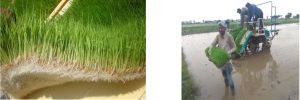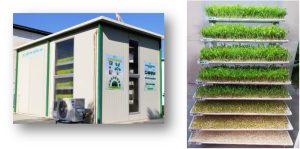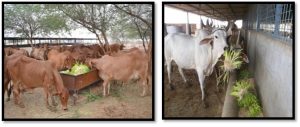Towards Better Animal Health & Production
I have been into sustainable integration of Livestock with Agriculture for creating value, not only for farmers but all the related stakeholders. Sustainable animal feeding and their health is an integral part of this economic value proposition. It is well established that about 65-70% of the total cost of livestock farming is attributed to feeding. Therefore, efficiency of livestock management and the prosperity of the Indian farmer are related to availability of feed and fodders, which is an integral component of nutrition and a natural diet for dairy animals. It is best for improving the quality as well as for production of milk. Green fodders enhance the content of polyunsaturated fatty acids, e.g., Omega 3; vitamins, minerals and carotenoids. The ancient script & science-based research suggest that use of green fodders for cows is helpful in production of milk, which is very rich in essential fatty acids (EFAs). Omega- 3 is the most important constituent of grass-fed cow milk. The increase in livestock population along with intensive rearing system has resulted in increased demands for feeds and fodder. Indian livestock suffer because of the gap between demand and supply of fodder. It is estimated that demand and supply of fodder and feed would be to the tune of 40% approximately. Intrested: Read More—–
Ayurvet ProGreen Hydroponics offers sustainable solution.
Fodder Production:
Fodder can be easily produced by farmers. However, the availability of land for fodder production is a big constraint. In urban Dairy it offers major challenge, impacting production, reproduction & health of livestock. The land availability for fodder and pasture is a meagre 4-5 per cent of the total cultivable land area. It is estimated that to meet the complete nutritional needs of the ever-increasing livestock population in India, at least 12 percent of the land should be secured for production of fodders. The competition between man and animal gives a natural precedence to cultivation of food grains, vegetables and fruits for the ever-growing human population. Therefore, the possibility of bringing more land under fodder crops or pastures is remote. With the growing population of both humans and livestock, managing food and feed for both is going to be a serious challenge. Apart from limitation on land and qualitative erosion of soil, agriculture faces limitation on availability of water. I am sure we all know that to produce one liter of milk we require 100 liters of water.
Hydroponics Technology:
The word hydroponics is derived from ‘Hydro’ means water and ‘Ponic’ means working. Thus, hydroponics is a process of growing plants with water and without soil. It is a technique where the physiological requirements of plants can be met without use of soil. In conventional system, seed start germinating when it gets favorable conditions like: Water, Air, Temperature and Light. A seed utilizes maximum energy from the nutrients stored in it for developing radical (roots), very less amount of energy is utilized for the growth of the plumule (shoot). Therefore in hydroponics technique, favorable conditions are provided to the seed so that the nutrients stored in the seed are directly utilized for development and growth of the plumule.
Benefits of Hydroponics:
Hydroponics techniques have proven useful and efficient for producing food for livestock. The technique is advantageous when compared to conventional agriculture because it controls the climatic conditions as well as plant nutrition. Hence, it is possible to get increased production, stable harvests of high-quality fresh feeds, which is available all the year, and can be produced on an industrial scale. The fodder is produced under safe conditions and are thus free from undesirable materials such as weeds, insects, dust, insecticides, germicides, carcinogens and radioactive substances. Hydroponics culture is probably the most intensive method of crop production in today’s agricultural industry. With the possibility of adjusting air and root temperature, light, water, plant nutrition and adverse climate, hydroponics agriculture can be made highly productive, conservative of water and land and protective of the environment. Some of the qualities of hydroponic fodder are identified below:
- Fodder is produced year-round under controlled climatic condition.
- Fodder is rich in minerals, proteins, amino acids and vital nutrients
- Fodder is of uniform quality, taste, tender, fresh and green
- Acceptability of fodder by animals is very high
- Fodder is free of diseases, residues of pesticides or chemicals, and is organic in nature.
- It improves the health, productivity, fertility and longevity of all livestock
- Saves cultivable land, water, labor, post-harvesting overheads
- Daily production eliminates need for storage space, cost of transport
- Saves from the worries arising from uncertainties of fodder supplies
Hydroponic Machine and Greenhouse:
Green feeds are grown in controlled environmental conditions with a temperature range of 15oC-32oC and a relative humidity of 80-85%. Green feed is grown in multilayer shelves. Natural light is let in through suitably glazed double layered windows. To save water, provision for recycling of water is made inside the greenhouse with water tank and pump facility. The Indian Council of Agricultural Research and NAAS had brainstorming on Hydroponics for fodder production and expressed the need of the technology for production of green fodder and yet save land and water. The irrigation of hydroponics fodder has been operated through manual or automatically controlled micro-sprinklers/ Foggers. A Hydroponics greenhouse may vary in size and can produce from 50 kg to 1000kg per day.
| Land required to produce 240 kg green feed / day for one year | |
| Hydroponics | 218 sq ft |
| Conventional | 37673 sq ft |
| Saving | 37455 sq ft |
Advantages: Hydroponic Versus Conventional Cultivation
According to the research studies carried to study some of the advantages of growing fodder through are discussed below.
- Saving of water – It takes just 2-3 liters of water to produce 1 Kg of green feed as compared with 80-90 liter/kg required in conventional system.
- Marginal land usage – On an average it requires less than 1/15th of the space needed by conventional agriculture to grow same amount of produce.
- Reduction in growth time – The growing time of hydroponics plants takes as little as 7 days from seed germination to a fully-grown plant at a height of 25.30 cm, ready for harvest. In addition, the biomass conversion ratio is as high as 6-8 times under optimum conditions.
- Fodder Needs: Each machine of APH 1000 can address the needs of green fodder of approx. 75 to 100 animals, depending on the milk production
- Reduced labor requirement – This process of growing cattle feed requires minimal man-hour ratio per day. It is as little as 2 to 3 hours per day, needed to maintain & produce hydroponics green feed, as compared to the many hours of intense labor required for growing the same amount of feed as a pasture crop.
- Constant feed supply – With our hydroponics machine, a consistent supply of green feed is guaranteed 365 days of the year.
- Completely natural – There are no pesticides or fungicides used for cultivation of crop and feed.
8) Enhancement of nutritional value – Hydroponic green feed is a highly nutritious feed, which contains more protein as compared to conventional content. It has a high energy, moisture and Vitamin A & E content. Maize, Barley and Oat green feed are successfully grown in the machine. Conversion ratio of seed to green feed is approx. 7 times. The nutrient contents of the Hydroponic green feed are higher as compared to conventional fodder, owing to the presence of seeds, roots and fodder. Therefore, the hydroponically produced green is referred as feed. In Hydroponic green feed, the quality seeds are provided with the right nutrient and ambient conditions. This leads to faster germination and higher biomass in shorter duration.
9) Power: These machines require regular power supply to operate; however, these machines can be operated through the biogas/solar as well. The power consumption may be around 50 units per day. However, when the temperature is ambient, the unit consumption of power can be as low as 5-10 units per day
10) Success: The success of Hydroponics lies in good quality seeds/grains, hygiene & maintenance of temperature and humidity inside the chamber.
Nutritional Value
| Fodder | % Protein | % Protein |
| Conventional Fodder | Hydroponics | |
| Maize | 10 | 14 |
| Barley | 12 | 18 |
| Oat | 11.5 | 13 |
Hy d r o p o n i c s fodders are fed along with the roots as against the conventional fodder being only the leafy materials. The c o n v e n t i o n a l roots are too hard and generally not available for feeding. The roots in hydroponics are actually freshly germinated seeds. They are very succulent. There is no wastage of roots and thus their nutritional value. Hydroponics fodders have good palatability.
The ICAR project, revealed that feeding hydroponic fodder had increased milk yield by 0.5-2.5 liters/ animal per day with increase in fat and SNF content of the milk. This increased their net profit by Rs. 25-50 per animal per day. In addition, the farmers reported improvement in health and conception rate of the dairy animals, reduction in cattle feed requirement by 25%, increase in taste (sweetness) of the milk, whiter milk, reduction in labor cost, requirement of less space and water, freshness and high palatability of the hydroponics fodder etc.
The Surat District Milk Producers’ Union Limited (SUMUL) has carried out experiments on heifers using the Ayurvet Hydroponics machine at Vanskoi farm. The machines is running on biogas as a source of conventional energy. The scientific studies conducted at SUMUL included feeding of hydroponics maize green feed to 20 heifers while another 20 heifers were given conventional feed. The experiment revealed that the hydroponic fed group had reproductive efficiencies, which were higher by 55%, body weight gain was higher by 20% and the cost of feeding was lower by 18%. It was observed that out of the 20 heifers kept on conventional feed only 11 conceived during the experimental period, while of the 20 on hydroponic fodder, 17 had conceived. This obviously suggests that hydroponic fodders can substantially help in reducing the first age at conception and may also prove a good source in improving the fertility of cows and buffaloes and thus reduce the intercalving period.
The Haryana Livestock Development Board conducted some experiments by feeding hydroponic fodder to bulls at their semen bank. They observed excellent results in terms of reproductive efficiency body weight gain and cost of feeding. The machines installed at Bikaner RAJUVAS indicated that feeding of feeding of Rati cows increased the milk production by approx. 10 to 15% and also helped in reducing the cost of feeding. The calf weight gain was much higher and better by 15 to 20%.
Innovation in RAJUVAS:
Some of the grasses available in India have high nutritional value and are very important in arid environments because they provide forage, which maintains both wild mammals and livestock. One such grass is sewan, found in western Rajasthan. Sewan rangelands are spread in the low rainfall (50-150 mm) zone of Bikaner, Jaisalmer and Barmer districts. Sewan (Lasiurus sindicus) is the most important perennial grass of western region of Rajasthan and has good drought tolerance capacity. Like other arable crops, proper time of sowing of grasses is of prime importance and success is dependent on it, whether it is renovation of old degraded pastures or establishment of new grasslands. However, there are major issues and problems in sowing of Sewan seed. Seed cannot be sown by seed drill and plough due to its very low weight. Further, seed have less reserve nutrient in their endosperms, which also inhibit their proper germination. When Sewan seed is broadcasted, most of them do not germinate as ants, rats, birds and even termites, pick them up. Alternative technology was used by making pellets in cow dung and to be broadcasted in the field after rain or just before rain. It should be protected from wind in the early stages of establishment. RAJUVAS has become the first university and Rajasthan the first state to undertake this innovation.
Hydroponics Technology for raising Paddy Nursery

Hydroponic Paddy Nursery Mechanical Transplanting of hydroponic Paddy
Indian farmers encounter several problems in establishing proper paddy nursery, transplanting survival, diseases, etc. Additionally, the traditional mat-type nursery requires cumbersome, labor-heavy land preparation. It also needs higher agrochemical input and regular watering. They also observed more incidences of contamination, yellowing of leaves, and tip burning because of the open field nursery preparation. Hydroponics may be one solution to the many problems currently affecting paddy growers in India such as adverse climate and diminishing land and water.
The hydroponics technique is also advantageous relative to conventional agriculture. Because the crops are grown under a controlled environment, the nursery is free from weeds and shielded from insects. As such, there is no need to use expensive and toxic pesticides or herbicides. The temperature, light, water, and nutrition can be fully adjusted to optimum conditions making the hydroponics paddy nursery highly productive even with limited water and land area. Seedlings grown using hydroponics paddy nursery establishes well in the field and can be useful particularly during delayed monsoon rains.
The Hydroponics Paddy (rice) Nursery Protocol
The Hydroponics Paddy Nursery grows rice seedlings are grown under a fully controlled environment and multilayer shelves. Hydroponics seven-day paddy growing cycle development. It only takes seven days for the rice seedlings to reach 15 centimeters at 30-33 C and 75-80% humidity. The humidity and temperature play a crucial role in the growth of the paddy nursery and can be adjusted to suit the crop requirement. The other advantages of hydroponics paddy nursery over conventional nursery cultivation are: Hydroponics-grown seedlings recover fast; produce tillers vigorously, mature uniformly, and have higher yield gain. Crops mature early leading to early harvesting and better returns Uses 95% less water, suitable for late delayed monsoon conditions, Land for nursery can be used for other purposes Mechanical transplanting ensures uniform spacing and plant density. Mechanized transplantation covers 3 to 4 acres per day with less work force
In collaboration with NABARD, Hydroponics was successfully demonstrated the benefits hydroponically grown nursery and its transplantation in the farmer fields. By promoting the wider use of hydroponics paddy nursery, the government can help Indian rice farmers save significant amounts of water, land, labor, time, and other resources. Organizing free training for farmers in different parts of the country will make them aware of the technology and its benefits, which empowers them.
Hydroponic for Wheat Grass
Wheat grass in the hydroponics system has been grown succesfully This grass is free from fertilizers, agrochemicals and pesticides. This hydroponically grown wheat grass has high quality nutrients and antioxidants. Wheatgrass consumption can boost the immune system and is helpful in improving the conditions of patients suffering from various lifestyle diseases like heart ailment, indigestion, cancer, diabetes, obesity, etc.

Hydroponics Technology for Food Production:
Hydroponics is also catering to emerging microgreens. Due to Covid 19, people have become more conscious about healthy diet. Now microgreens can be developed in specially developed Hydroponics machine in 10-20 days.
Way Forward
Hydroponics Fodder has definitely proved to be source of better quality of nutrition for improving the health and productivity of all livestock and human beings. This technology has power to save water, land and provide employment to rural youth. The government is already providing incentives and subsidies for various irrigation technologies such as micro irrigation, drip irrigation, sprinkler irrigation and on power and water supply for agriculture. The government is also providing subsidy on fertilizers and seeds. All these schemes may be applied to hydroponic fodder production to provide support to our dairy farmers and help them to be successful DF
Ayurvet Pro Green Hydroponics Technology
In India, Hydroponics technology is gaining momentum; while all the developed countries have adopted this technology. Ayurvet Research Foundation (ARF) took pioneering step to develop Hydroponics machines in India. Post it’s testing the Ministry of Agriculture, Government of India has certified for its had approved and shared the commercial test report to Ayurvet’s Hydroponics machine which is the first machine to get the same. Ayurvet has also got Patent (293138) for the process and design of the machine. Since 2009, certain innovations were made in the design and process of production to make it economically viable.

Ayurvet Pro Green Hydroponics Machine Hydroponic Green Fodder
Despite India being largest producer of milk in the world, we are not able to provide balanced animal nutrition to animal. Balanced nutrition is key to healthy animal, which will produce healthy milk or meat.

Cows enjoying hydroponic Green Fodder
Green fodder is the key for better production, animal health, and milk quality. Ayurvet Pro Green hydroponics technology was evolved for green fodder production and its availability round the year.
Hydroponics system also eliminates additional pressure on water and land resources. The process of growing green fodder hydroponically allows the control of climatic conditions for optimum growth with guaranteed output per day. In current scenario this could be a viable alternative for feeding animals.
Source : Guest blog by Dr Anup Kalra Former Executive Director Ayurvet, CEO (ARF), Director QCS Herbals and Alternate Green Energy Solutions Private Limited Former President CLFMA North
Dairynews7x7 Aug 24th 2025